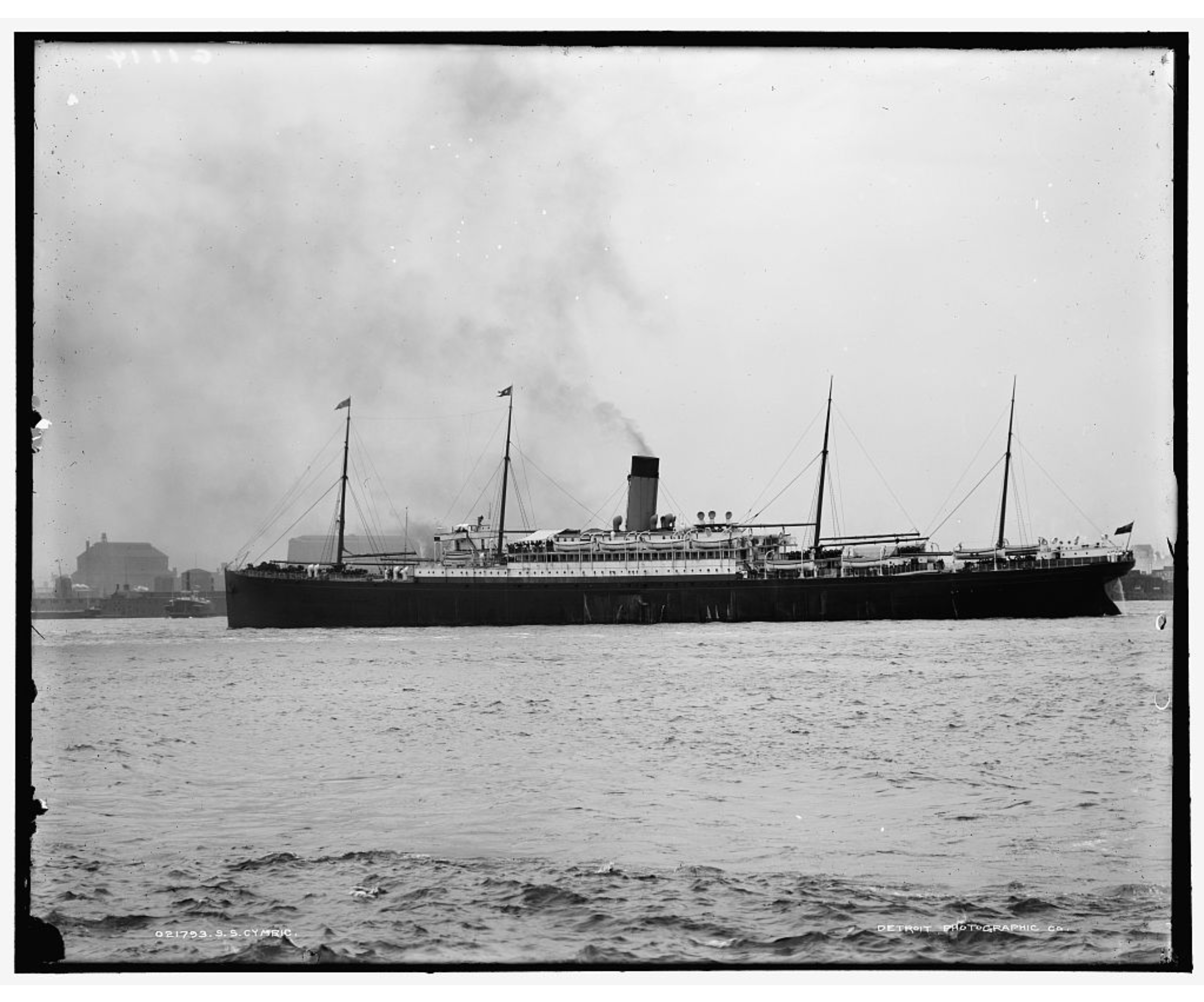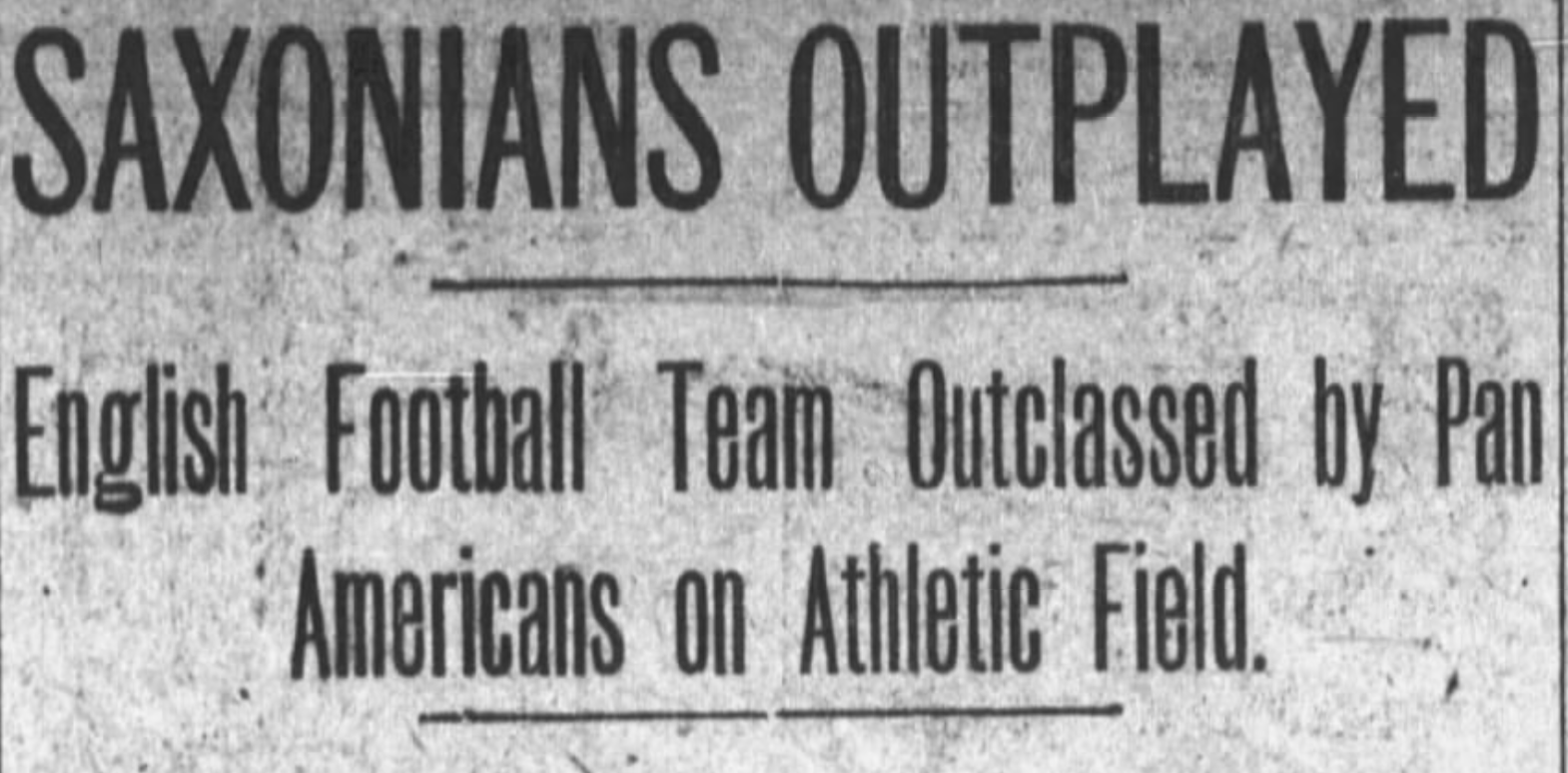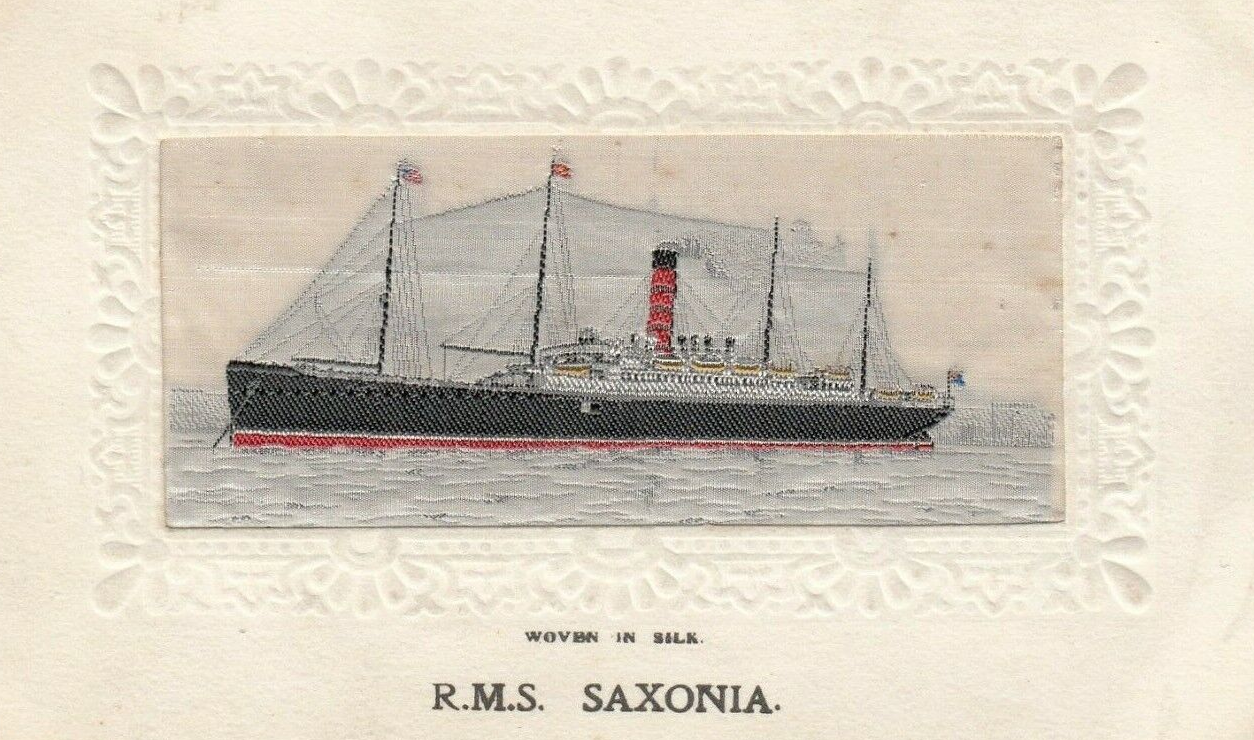Many thanks to Kurt Rausch, Tom McCabe, and Brian D. Bunk for their help and comments. Any errors below are my own.
British ocean liner teams play in Massachusetts and Rhode Island
In December 1893, a brief report in the Fall River Daily Evening News on soccer teams among the crews of the White Star Line said the Majestics were “anxious to meet some of the New England teams.” The Fall River-Pawtucket soccer scene was then arguably the best in the United States, and it is understandable the Majestics would want to test themselves there given their dominance at the time of New York and Northern New Jersey teams. Two years later, the Majestics finally made it to New England for a match. However, their opponent wasn’t a team from Fall River or Pawtucket, where soccer was now entering a period of contraction. Instead, the Majestics played the Thistle team of Holyoke, Massachusetts, where organized soccer was beginning to lay roots.
The match report for the 3-3 draw on May 18, 1895, notes that a “good-sized crowd composed mainly of Scots and Englishmen” was on hand at Hampden Park to witness the “association or Scottish game.” The report also makes clear the match “was unintelligible to most of the Americans present,” explaining, “the only thing interesting to them being the sight of 22 men playing football without incurring bloody noses, broken collar-bones, fractured ribs and the other discomforts incident to the native game.” How the match came to be organized, how the Majestics travelled to the match, and what money or other compensation the Majestics may have received are all unknown. But we do have a description of the teams’ kits: “The Majestics wore a uniform of short duck pants, red shirts on which was a white star, and short golf stockings. The uniforms of the Thistles were the same with the exception of yellow and black jerseys.”[1]

A few logistical details can be surmised from other sources. The Majestic arrived in New York on Wednesday, May 15, 1895, having departed Liverpool on May 8 before picking up more passengers at Queenstown (present day Cobh) in Ireland. On board were 355 cabin and 1,026 steerage passengers for a voyage that took 6 days, 2 hours and 31 minutes (the time of passage began with the departure from Queenstown and ended with a ship’s arrival at Sandy Hook at the entrance to the Lower New York Bay).[2] The match in Holyoke was played on a Saturday. Travel from New York to Massachusetts at this time typically began with overnight passage by ship from New York City. The premier steamer line for this passage was the Fall River Line. Traveling on one of the Fall River Line steamers meant departing from Pier 14 in Manhattan for a nine-hour overnight passage through Long Island Sound to Fall River. This was the route taken by New Jersey, New York, and Pennsylvania teams to face Fall River and Pawtucket sides. From there passengers could board a New York, New Haven and Hartford Railroad Line train for a one-hour-and-forty-minute trip by rail to Boston.[3] But Holyoke is ninety minutes west of Boston. Perhaps the Majestics traveled by steamer or rail to New Haven and then to Holyoke. However it was done, travel for the match involved a significant investment of time and money. If the Majestics left New York on Friday, the day before the game and, as the match report indicates, began their return trip the night of the game to arrive back in New York on Sunday, three travel days were necessary for a 90-minute match. It was a challenging trip for leading US clubs, let alone a visiting ocean liner team.
Reports of games involving British ocean liner teams in New England are spotty after the Majestics 1895 visit to Holyoke, with the next identified match being a 4-0 win in November 1902 by the Roxbury team in Boston over a team from the Cunard Line steamship Saxonia.[4] Launched in 1899, the Saxonia began service on the Liverpool to Boston route in May 1900. After that 1902 match, no other reports of games against British ocean liner teams in New England have been identified until reports of nine games in 1905 played in Boston, Fall River, and Fairlawn near Pawtucket involving four steamships: Saxonia and Ivernia from the Cunard Line, and Cymric and Romanic from the White Star Line, all ships on the Liverpool to Boston route. There are several explanations for the paucity of newspaper reports. The Fall River and Pawtucket soccer scenes, so dominant in American Cup play in the second half of the 1880s and first half of the 1890s before the economic effects of the Panic of 1893 and dramatically declining rates of immigration from Britain retarded soccer’s development, were beginning to reawaken at the start of the 1900s. But the financial stability of both soccer communities was still being reestablished, which meant there were little resources to host visiting teams. In Boston, soccer was always under the shadow of American football, which meant little newspaper coverage; most soccer coverage that did occur came in the form of brief match reports. While teams had been formed there by 1888 and the city was home to a team in the short-lived ALPF, little soccer activity is reported in Boston newspapers through the 1890s. This began to change with the formation of the Merrimac Valley League at the turn of the century and gained more momentum when Harvard University organized a soccer team in December 1904.[5]
In January 1905, the Fairlawns hosted the Cymric Tars, based on the White Star Line’s Cymric. The reigning champions of the Rhode Island League, the Fairlawns were named after a village located just outside of Pawtucket. As was the case when the Majestics visited Holyoke seven years before, little information has been found to explain how a team based on a ship docked in Boston came to travel fifty miles to Fairlawn for a game of soccer. One report notes the “association football contest of the ‘international’ variety” had been arranged by Wynn Parker, “the enterprising manager of the Fairlawns.” The same report described the Cymric Tars as a “crack aggregation, all the players of prominence in contests on the other side.” The report also related, “When the Cymric docked at New York the team piled up a winning record against New York and Jersey teams.”[6] This observation, if true, underscores the likelihood that many matches involving British ocean liner teams simply were not reported; no match reports from New York or New Jersey newspapers of clubs there playing the Cymric Tars have been found.

The visit of the Cymric Tars to Fairlawn was as much a social as a sporting event, one in which civic pride was clear. Members of the Fairlawn Athletic Association greeted the visiting team when it arrived at the Pawtucket train depot following an hour-long train ride from Boston. After being treated to lunch, the match was scheduled to begin early enough for the Cymrics to “enjoy a bounteous supper” before catching the train back to Boston. The Pawtucket Evening Times explained, “The Fairlawns feel proud to think that these Jack Tars should choose to arrange a game of association football with them. The Fairlawns won the championship of the Rhode Island League last season, this probably being the reason why the Cymric Tars desired to make an effort to trim them on their own grounds.”[7]
On January 21, 1905, the Fairlawns easily defeated the Cymric Tars 4-0 in the match played at the Smithfield Avenue Grounds before two thousand spectators. One report observed, “To give the Cymric stars credit for more scientific play than the locals would be hardly putting it right, in the face of the results, but many spectators freely expressed this opinion. From the start Fairlawn outplayed the sailor team and never allowed it to settle into a successful passing game.”[8] Another report detailed the hospitality enjoyed by the visitors: lunch concluded with cigars and “a season of short stories” before Cymric Tars manager Thomas Sheerin presented Fairlawns manager Parker with “a fine brass football pump as a token of friendship.” After the game both teams “partook of a daintily served English Tea” followed by a program of music and recitations and the exchange of more gifts before the visitors boarded the train to return to Boston.[9] Real personal connections seem to have been made during the visit. A month after the match, Sheerin returned to Fairlawn to visit newly made friends, bringing along with him one of his team’s new uniforms, “consisting of a handsome red blouse with a large white star on front, and blue trousers.” Sheerin also presented Fairlawns manager Parker with “a handsome regulation football, made in England” to go along with the pump he had gifted earlier. Other visits to Fairlawn by members of the Cymric team were also reported.[10] In April, “a good sized delegation of the Fairlawn footballists” traveled to Boston to see their new friends play the Boston Rovers, winners of the Merrimack Valley League in 1903 and 1904. While the Cymric Tars lost 3-1, their style of play was praised: “The Cymrics play an exceedingly clean and clever, gentlemanly game, their tactics being much less rough than those of the association football elevens who have become Americanized.” Sadly, a second match in Fairlawn could not be scheduled because the Cymric’s day of departure from Boston had been changed from Wednesdays to Sundays, making a weekend visit impossible.[11]

The Fairlawns comfortable win over the Cymric Tars was soon echoed in Fall River. On March 11, 1905, the Fall River Pan Americans hosted the team from the Cunard Line’s Saxonia at the Bedford Street Grounds. Winter weather had resulted in three months with no soccer games played and the visit by a British team, one with “an international reputation” and reported to “have defeated some of the best teams across the water,” was greatly anticipated.[12] Hopes for a first-class match “were rudely shattered” when the Saxonians “proved themselves to be a very inferior aggregation,” the Pan Americans finishing with an easy 9-0 victory: “At no stage of the game had the Saxonians a chance.” The Fall River Daily Globe reported, “The Saxonians have met and defeated the various teams that are on the big liners, but as one of their number said to a reporter, they had never played any of the first class teams across the pond. They did not fully realize what they were stacked up against until the first half was over [when they were losing 3-0], and then a few of them commenced to wonder and undoubtedly came to the conclusion that America has at least one football team capable of giving the best teams in England a run for their money.”[13] The Fall River Evening Herald called the match “a decidedly poor exhibition of football,” adding, “The contest seemed all the poorer because of the reputation the visitors had as players of the game, a reputation that from the first was seen to be entirely undeserved or else the Saxonians had a day off.”[14] The Fall River Daily Evening News echoed other local reports: “The visitors were touted as champions of the ‘Western seas,’ whatever that may mean, but their inability to cope with the Pan Americans was evident from the kickoff. The game was painfully one-sided and the spectators were disappointed even before the first half was over…It was agreed to play 30-minute halves, and as the result proved it was about an hour too much of the game that was presented.”[15] Fall River was a soccer town and its newspapers, long experienced in covering the game, did not hesitate to call out inferior teams.
If teams from British ocean liners proved no match for experienced clubs in Fairlawn and Fall River, they managed to find more success against nonleague sides in Boston. A month after their defeat to the Fairlawns, the Cymric Tars defeated the team from the Cunard Lines’ Ivernia 3-2 before defeating the Fort Warren team 2-1 in November. Made up of soldiers manning the coastal artillery installation that guarded the entrance to Boston Harbor, the Fort Warren team had lost 4-2 in October to the team from the White Star Line steamship Romanic, a game that was reported under the eye-catching headline “Sailor Sockers Beat Soldiers.”[16] Also in October, the same month the Pilgrims defeated a greater-Boston side 5-0, the Everett team lost 4-2 to the Saxonians before finding revenge in a thumping 11-0 win over the seamen in November, the same month the Brockton team fell 3-0 to the Ivernians.[17]
Endnotes
[1] “Association Football,” Springfield Republican, May 19, 1895, 2.
[2] “Incoming Steamers,” New York Times, May 15, 1895, 14; “Miscellaneous,” Wall Street Journal, May 15, 1895, 4.
[3] Klark Jessen, “Remembering the Fall River Line,” MassDOT Blog, Feb. 28, 2015, https://blog.mass.gov/transportation/mbta/remembering-the-fall-river-line/; Oliver Jensen, “The Old Fall River Line,” American Heritage 6, no. 11 (December 1954), https://www.americanheritage.com/old-fall-river-line
[4] “Roxbury Defeats Saxonia,” Boston Herald, Nov. 30, 1902, 9.
[5] “Boston Rovers Out to Win Merrimac Valley Football League Trophy,” Boston Daily Globe, Apr. 27, 1905, 5; “Association Football at Harvard,” Boston Daily Globe, Dec. 3, 1904, 4.
[6] “Local Sports Notes,” Pawtucket Evening Times, Jan. 18, 1905, 2.
[7] “Fairlawn,” Pawtucket Evening Times, Jan. 20, 1905, 12.
[8] “Association Football,” Boston Globe, Jan. 22, 1905, 6; “Champion Fairlawns Just Galloped by Cymric Sailor Players Saturday,” Pawtucket Evening Times, Jan. 23, 1905. 2.
[9] “Fairlawn,” Pawtucket Evening Times, Jan. 23, 1905, 4.
[10] “Fairlawn,” Pawtucket Evening Times, Feb. 24, 1905, 12; “Fairlawn,” Pawtucket Evening Times, Feb. 28, 1905, 6.
[11] “Attended Game in Boston,” Pawtucket Evening Times, Apr. 3, 1905, 4; “Boston Rovers Out to Win Merrimac Valley Football League Trophy,” 5.
[12] “English Team Coming,” Fall River Daily Globe, Mar. 4, 1905, 1.
[13] “Easy Winners,” Fall River Daily Globe, Mar. 13, 1905, 6.
[14] “Saxonians Outplayed,” Fall River Evening Herald, Mar. 13, 1905, 2.
[15] “Saxonias Slow,” Fall River Daily Evening News, Mar. 13, 1905, 7.
[16] “Fairlawn,” Pawtucket Evening Times, Feb. 28, 1905, 6; “Cymric 2, Fort Warren 1,” Boston Daily Globe, Nov. 9, 1905, 9; Cymric 2, Fort Warren 1,” Boston Daily Globe, Nov. 9, 1905, 9; “Cymric 2, Fort Warren 1,” Boston Daily Globe, Nov. 9, 1905, 9; “Sailor Sockers Beat Soldiers,” Boston Herald, Oct. 27, 1905, 9;
[17] “Greater Boston Team Beaten at Socker,” Boston Herald, Oct. 17, 1905, 9. “Saxonia 4, Everett 2,” Boston Herald, Oct. 8, 1905, 6. “Everett 11, SS Saxonia 0,” Boston Daily Globe, Nov. 5, 1905, 2; “SS Ivernia 3, Brockton 0,” Boston Daily Globe, Nov. 19, 1905, 10.


Great stuff!
One small error though: Holyoke is west of Boston, not east. Else it would be in the Atlantic Ocean.
Doh! Thank you for pointing out the error.
Ed
Pingback: Sailor lads, jolly tars, and rovers of the briny deep: International ship-crew soccer matches in the US, 1890-1905, part 1 – Society for American Soccer History
My Grandfather, Robert Munro, was a Member of the Fairlawn Rovers Team that was located on Smithfield Avenue in the Village of Fairlawn in Pawtucket, RI.